Lithochemical Stream Sediments of the Dukat Gold–Silver Ore-Forming System (North–East of Russia)
Abstract
:1. Introduction
2. Study Areas: Geology, Ore Mineralization, Geography and Climate
2.1. Geological Setting
2.2. Ore Mineralization
2.3. Geography and Climate
3. Research Methods
3.1. Methods of Geochemical Research
3.2. Analysis Methods
3.3. Methods of Information Mathematical Processing
4. Results and Discussion
4.1. Lithochemical Stream Sediments in the AGF Study of the Dukat Gold–Silver Ore-Forming System and Associated Areas—Regional Forecast
4.2. Lithochemical Stream Sediments in the AGF Study of the Dukat Gold–Silver Deposit—Prospecting and Evaluation
4.3. Bryolithochemical Research When Prospecting for Gold–Silver Mineralization Based on the Stream Sediments
4.4. The Binding Forms of Element Indicators of Gold–Silver Mineralization in Lithochemical Stream Sediments
5. Conclusions
Author Contributions
Funding
Acknowledgments
Conflicts of Interest
References
- NEDRADV. Russian Resources. Gold of Russia. 2017. Available online: https://nedradv.ru/nedradv/ru/resources/?obj=ab05b068239ede80d3dd35cf40638bd2 (accessed on 4 December 2019). (In Russian).
- NEDRADV. Russian Resources. Silver of Russia. 2017. Available online: https://nedradv.ru/nedradv/ru/resources/?obj=ab05b068239ede80d3dd35cf4069b0ca (accessed on 4 December 2019). (In Russian).
- Struzhkov, S.F.; Konstantinov, M.M. The Metallogeny of Gold and Silver in the Okhotsk–Chuckchee Volcanogenic Belt; Nauchny Mir: Moscow, Russia, 2005; p. 320. (In Russian) [Google Scholar]
- Benevolsky, B.I.; Vartanyan, S.S.; Volchkov, A.G.; Kurbanov, N.K.; Novikov, V.P.; Struzhkov, S.S. The status, problems and development ways of noble metals’ mineral resource base. Rudy Met. 2009, 1, 14–18. (In Russian) [Google Scholar]
- Mikhailov, B.K.; Benevolsky, B.I.; Vartanyan, S.S.; Volchkov, A.G.; Migachev, I.F. The status and development ways of Russia noble and nonferrous metals’ mineral resource base. Razved. Okhrana Nedr 2012, 9, 76–83. (In Russian) [Google Scholar]
- Mikhailov, B.K.; Ivanov, A.I.; Vartanyan, S.S.; Benevolsky, B.I. Problems of the Russian gold mineral resource base. Rudy Met. 2015, 1, 93–99. (In Russian) [Google Scholar]
- Ivanov, A.I.; Vartanyan, S.S.; Chernykh, A.I.; Benevolskiy, B.I.; Golubev, Y.K. The status and development prospects of Russian diamonds and gold mineral resource base. Razved. Okhrana Nedr 2016, 9, 95–100. (In Russian) [Google Scholar]
- Ivanov, A.I.; Chernykh, A.I.; Vartanyan, S.S. The status, development and exploration prospects of the gold mineral resource base in the Russian Federation. Otechestvennaya Geol. 2018, 1, 18–28. (In Russian) [Google Scholar]
- Kvashnevskaya, N.V. Prospecting for ore deposits on stream sediments. In Geochemical Prospecting for Ore Deposits in the USSR; Gosgeoltekhizdat: Moscow, Russia, 1957; pp. 146–157. (In Russian) [Google Scholar]
- Bogolyubov, A.N.; Sochevanov, N.N. Small-scale metallometric searches for polymetals on halos and stream sediments. Razved. Okhrana Nedr 1959, 10, 9–12. (In Russian) [Google Scholar]
- Krasnikov, V.I. Rational Method Fundamentals of Ore Deposit Prospecting; Gosgeoltekhizdat: Moscow, Russia, 1959; p. 412. (In Russian) [Google Scholar]
- Polikarpochkin, V.V. Geochemical methods for ore deposit prospecting on stream sediments. Sov. Geol. 1963, 4, 63–76. (In Russian) [Google Scholar]
- Polikarpochkin, V.V. Secondary Halos and Stream Sediments; Nauka: Novosibirsk, Russia, 1976; p. 408. (In Russian) [Google Scholar]
- Solovov, A.P. Actual situation and development perspectives of geochemical methods for ore deposit prospecting. Vestn. Mosk. Univ. Seriya Geol. 1978, 2, 3–28. (In Russian) [Google Scholar]
- Solovov, A.P. Geochemical Methods for Mineral Deposit Prospecting; Nedra: Moscow, Russia, 1985; p. 294. (In Russian) [Google Scholar]
- Solovov, A.P.; Arkhipov, A.Y.; Bugrov, V.A.; Vorobyev, S.A.; Gershman, D.M.; Grigoryan, S.V.; Kvyatkovsky, E.M.; Matveev, A.A.; Milyaev, S.A.; Nikolaev, V.A.; et al. Handbook of Geochemical Prospecting for Minerals; Nedra: Moscow, Russia, 1990; p. 335. (In Russian) [Google Scholar]
- Abisalov, E.G. Advanced lithochemical searches on stream sediments. Razved. Okhrana Nedr 1977, 9, 20–24. (In Russian) [Google Scholar]
- Pitul’ko, V.M.; Kritsuk, I.N. Data Interpretation Basics of Prospecting Geochemistry; Nedra: Leningrad, Russia, 1990; p. 336. (In Russian) [Google Scholar]
- Kravtsova, R.G.; Zakharov, M.N.; Ivanov, O.P. Combined geochemical investigations of the Pestrinsk silver-bearing field (Northeast Russia). Geol. Ore Depos. 1996, 38, 378–389. [Google Scholar]
- Sokolov, S.V. Structures of Anomalous Geochemical Fields and Mineralization Forecasting; Nauka: Saint Petersburg, Russia, 1998; p. 154. (In Russian) [Google Scholar]
- Domchak, V.V. Some features of ore substance scattering in mountain river alluvium of Stanovoy ridge. Razved. Okhrana Nedr 2008, 4–5, 99–103. (In Russian) [Google Scholar]
- Romanov, V.A. Stream sediments: Theory, methodology and practice. Ways of further development. Otechestvennaya Geol. 2008, 1, 78–82. (In Russian) [Google Scholar]
- Kravtsova, R.G.; Pavlova, L.A.; Rogozina, Y.I. Modes of Ag occurrence in the loose deposits of dispersal trains at Au–Ag mineral deposits. Geochem. Int. 2010, 48, 731–736. [Google Scholar] [CrossRef]
- Kravtsova, R.G.; Pavlova, L.A.; Rogozina, Y.I.; Makshakov, A.S. First data on forms of gold occurrence in lithochemical sedimental streams of the gold-silver Dukat deposit (Northeastern Russia). Dokl. Earth Sci. 2010, 434, 1184–1191. [Google Scholar] [CrossRef]
- Kravtsova, R.G.; Makshakov, A.S. Stream sediments of gold–silver ore-forming systems (Balygychan–Sugoisk depression, Northeast of Russia). In Gold of the North Pacific Rim, Proceedings of the Geology & Mining Conference and II International Geology & Mining Forum dedicated to Yu. A. Bilibin’s 110th anniversary, Magadan, Russia, 3–5 September 2011; Goryachev, N.A., Ed.; NEISRI FEB RAS: Magadan, Russia, 2011; pp. 249–250. [Google Scholar]
- Matveev, A.A.; Solovov, A.P. Geochemical Methods for Mineral Deposit Prospecting; KDU: Moscow, Russia, 2011; p. 564. (In Russian) [Google Scholar]
- Romanov, V.A. The method of geochemical search for and quantification of mineralization in stream sediments. Rudy Met. 2011, 3–4, 144–145. (In Russian) [Google Scholar]
- Kravtsova, R.; Makshakov, A. Anomalous geochemical fields of Au–Ag ore-forming systems of the Northern Priokhotje (Russia). In Geoanalysis 2012, Proceedings of the 8th International Conference on the Analysis of Geological and Environmental Materials, Buzios, Brazil, 16–20 September 2012; International Association of Geonalysts: Buzios, Brazil, 2012; Abstract PT.62; p. 123. [Google Scholar]
- Kravtsova, R.G.; Tarasova, Y.I.; Makshakov, A.S.; Pavlova, L.A. Distribution and modes of occurrence of Au, Ag, and associated elements in the sediment streams of Au–Ag zones at the Dukat deposit (Northeastern Russia). Russ. Geol. Geophys. 2016, 57, 529–548. [Google Scholar] [CrossRef]
- Kitaev, N.A.; Spiridonov, A.M.; Zorina, L.D. Gold-Bearing Formations of Eastern Transbaikalia and Amur Region: Ore Genesis Conditions, Composition and Structure of Geochemical Fields; Academic Publishing House “Geo”: Novosibirsk, Russia, 2018; p. 228. (In Russian) [Google Scholar]
- Hawkes, H.E.; Webb, J.S. Geochemistry in Mineral Exploration; Mir: Moscow, Russia, 1964; p. 488. (In Russian) [Google Scholar]
- Levinson, A. Introduction to Exploration Geochemistry; Mir: Moscow, Russia, 1976; p. 449. (In Russian) [Google Scholar]
- Brown, B.W. Error in lead anomalous stream sediments. Econ. Geol. 1970, 65, 514–515. [Google Scholar] [CrossRef]
- Bradshaw, P.M.D.; Clews, D.R.; Walker, J.L. Exploration Geochemistry; Barringer Research Ltd.: Rexdale, ON, Canada, 1972; p. 304. [Google Scholar]
- Hawkes, H.E. The downstream dilution of stream sediment anomalies. J. Geochem. Explor. 1976, 6, 345–358. [Google Scholar] [CrossRef]
- Levinson, A.A. Introduction to Exploration Geochemistry, 2nd ed.; Applied Publishing: Wilmette, IL, USA, 1980; p. 924. [Google Scholar]
- Chork, C.Y.; Cruikshank, B.I. Statistical map analysis of regional stream-sediment data from Australia. J. Geochem. Explor. 1984, 21, 405–419. [Google Scholar] [CrossRef]
- Day, S.J.; Fletcher, W.K. Effects of valley and local channel morphology on the distribution of gold in stream sediments from Harris Creek, British Columbia, Canada. J. Geochem. Explor. 1989, 32, 1–16. [Google Scholar] [CrossRef]
- Siegel, F.R. Exploration for Mississippi-Valley type stratabound Zn ores with stream suspensates and stream sediments, Virginia, U.S.A. J. Geochem. Explor. 1990, 38, 265–283. [Google Scholar] [CrossRef]
- Fletcher, W.K.; Loh, C.H. Transport equivalence of cassiterite and its application to stream sediment surveys for heavy minerals. J. Geochem. Explor. 1996, 56, 47–57. [Google Scholar] [CrossRef]
- Xie, X.; Mu, X.; Ren, T. Geochemical mapping in China. J. Geochem. Explor. 1997, 60, 99–113. [Google Scholar]
- Melo, G.; Fletcher, W.K. Dispersion of gold and associated elements in stream sediments under semi-arid conditions, northeast Brazil. J. Geochem. Explor. 1999, 67, 235–243. [Google Scholar] [CrossRef]
- Naseem, S.; Sheikh, S.A.; Qadeeruddin, M.; Shirin, K. Geochemical stream sediment survey in Winder Valley, Balochistan, Pakistan. J. Geochem. Explor. 2002, 76, 1–12. [Google Scholar] [CrossRef]
- Ohta, A.; Imai, N.; Terashima, S.; Tachibana, Y. Influence of surface geology and mineral deposits on the spatial distributions of elements concentrations in the stream sediments of Hokkaido, Japan. J. Geochem. Explor. 2005, 86, 86–103. [Google Scholar] [CrossRef]
- Macdonald, E.H. Handbook of Gold Exploration and Evaluation; Woodhead Publishing Limited: Cambridge, UK, 2007; p. 647. [Google Scholar]
- Carranza, E.J.M. Analysis and mapping of geochemical anomalies using logratio-transformed stream sediment data with censored values. J. Geochem. Explor. 2011, 110, 167–185. [Google Scholar] [CrossRef]
- Yousefi, M.; Carranza, E.J.M.; Kamkar-Rouhani, A. Weighted drainage catchment basin mapping of geochemical anomalies using stream sediment data for mineral potential modeling. J. Geochem. Explor. 2013, 128, 88–96. [Google Scholar] [CrossRef]
- Ali, L.; Williamson, B.J.; Moon, C.J.; Shah, M.T.; Khattak, S.A. Distribution of gold in different size fractions of stream sediments as a guide to bedrock gold mineralisation along the Shyok Suture Zone and adjacent areas of the Kohistan Island Arc, Pakistan. Arabian J. Geosci. 2015, 8, 2227–2235. [Google Scholar] [CrossRef]
- Yilmaz, H.; Sonmez, F.N.; Carranza, E.J.M. Discovery of Au–Ag mineralization by stream sediment and soil geochemical exploration in metamorphic terrain in western Turkey. J. Geochem. Explor. 2015, 158, 55–73. [Google Scholar] [CrossRef]
- Chen, X.; Zheng, Y.; Xu, R.; Wang, H.; Jiang, X.; Yan, H.; Cai, P.; Guo, X. Application of classical statistics and multifractals to delineate Au mineralization-related geochemical anomalies from stream sediment data: A case study in Xinghai-Zeku, Qinghai, China. Geochem. Explor. Environ. Anal. 2016, 16, 253–264. [Google Scholar] [CrossRef]
- Xiao, F.; Chen, J.; Hou, W.; Wang, Z.; Zhou, Y.; Erten, O. A spatially weighted singularity mapping method applied to identify epithermal Ag and Pb–Zn polymetallic mineralization associated geochemical anomaly in Northwest Zhejiang, China. J. Geochem. Explor. 2018, 189, 122–137. [Google Scholar] [CrossRef]
- Chen, D.; Wei, J.; Wang, W.; Shi, W.; Li, H.; Zhan, X. Comparison of methods for determining the thresholds of geochemical anomalies and the prospecting direction—A case of gold deposits in the Gouli exploration area, Qinghai Province. Minerals 2019, 9, 368. [Google Scholar] [CrossRef] [Green Version]
- Shahrestani, S.; Mokhtari, A.R.; Carranza, E.J.M.; Hosseini-Dinani, H. Comparison of efficiency of techniques for delineating uni-element anomalies from stream sediment geochemical landscapes. J. Geochem. Explor. 2019, 197, 184–198. [Google Scholar] [CrossRef]
- Yu, X.; Xiao, F.; Zhou, Y.; Wang, Y.; Wang, K. Application of hierarchical clustering, singularity mapping, and Kohonen neural network to identify Ag–Au–Pb–Zn polymetallic mineralization associated geochemical anomaly in Pangxidong district. J. Geochem. Explor. 2019, 203, 87–95. [Google Scholar] [CrossRef]
- Zomorrodian, M.; Shayestehfar, M.R. Indicator ratios and additive composite halos in stream sediment samples as a geochemical indicator for identifying promising epithermal gold deposit in the north of Kashmar. Arabian J. Geosci. 2019, 12, 331. [Google Scholar] [CrossRef]
- Kravtsova, R.G. Geochemistry and Forming Conditions of Gold–Silver Ore-Forming Systems, Northern Pre Okhotsk Region; Academic Publishing House “Geo”: Novosibirsk, Russia, 2010; p. 292. (In Russian) [Google Scholar]
- Belyi, V.F. Geology of the Okhotsk Chukotsk Volcanogenic Belt; NEISRI FEB RAS: Magadan, Russia, 1994; p. 76. (In Russian) [Google Scholar]
- Belyi, V.F. Problems of geological and isotopic age of the Okhotsk–Chukotsk Volcanogenic Belt (OCVB). Stratigr. Geol. Correl. 2008, 16, 639–649. [Google Scholar] [CrossRef]
- Sidorov, A.A.; Volkov, A.V.; Alekseev, V.Y.; Belyi, V.F.; Kolova, E.E. The gold–silver Okhotsk–Chukotka volcanic belt. Geol. Ore Depos. 2009, 51, 441–455. [Google Scholar] [CrossRef]
- Belyi, V.F. Stratigraphy and Structures of the Okhotsk–Chukotsk Volcanogenic Belt; Nauka: Moscow, Russia, 1977; p. 171. (In Russian) [Google Scholar]
- Goncharov, V.I.; Alshevsky, A.V.; Vortsepnev, V.V. Geology and Minerals of North–East Asia; Nauka: Vladivostok, Russia, 1984; p. 128. (In Russian) [Google Scholar]
- Umitbaev, R.B. Okhotsk–Chaun Metallogenic Province; Nauka: Moscow, Russia, 1986; p. 286. (In Russian) [Google Scholar]
- Bogdanov, N.A.; Til’man, S.M. Tectonics and Geodynamics of North–East Asia: Explanatory Note to Tectonic Map of North-East Asia, 1:5,000,000 Scale; Institute of Lithosphere RAS: Moscow, Russia, 1992; p. 54. (In Russian) [Google Scholar]
- Bogdanov, N.A.; Til’man, S.M. North–East Asia Tectonic Map of 1:5,000,000 Scale; Pushcharovsky, Y.M., Ed.; Committee on Geodesy and Cartography of the Russian Federation: Moscow, Russia, 1992; 1 sheet. (In Russian) [Google Scholar]
- Kotlyar, I.N.; Rusakova, T.B. Cretaceous Magmatism and Ore-Bearing Capacity of the Okhotsk–Chukotsk Region: Geological–Geochronological Correlation; Neisri Feb Ras: Magadan, Russia, 2004; p. 152. (In Russian) [Google Scholar]
- Akinin, V.V.; Khanchuk, A.I. The Okhotsk–Chukotka volcanogenic belt: Age revision based on new 40Ar/39Ar and U-Pb isotope data. Dokl. Earth Sci. 2005, 405, 1131–1135. [Google Scholar]
- Kuznetsov, V.M.; Livach, A.E. Construction and metallogenic zoning of the Balygychan–Sugoy trough. In Problems of Metallogeny of Ore Regions in North–East of Russia: Proceedings; Goncharov, V.I., Kuznetsov, V.M., Eds.; NEISRI FEB RAS: Magadan, Russia, 2005; pp. 156–177. (In Russian) [Google Scholar]
- Volkov, A.V. Gold and silver metallogeny in the Okhotsk–Chukotka volcanic belt. Geol. Ore Depos. 2007, 49, 238–240. [Google Scholar] [CrossRef]
- Sidorov, A.A.; Chekhov, A.D.; Volkov, A.V.; Alekseev, V.Y. Metallogeny of the inner and outer zones of the Okhotsk–Chukotsk volcanogenic belt. Dokl. Earth Sci. 2011, 439, 949–954. [Google Scholar] [CrossRef]
- Ganelin, A.V.; Vatruchkina, E.V.; Luchitskaya, M.V. New data on the volcanism of the Central Chukotka segment of Okhotsk–Chukotka volcanogenic belt. Dokl. Earth Sci. 2019, 485, 252–256. [Google Scholar] [CrossRef]
- Tsopanov, O.K. Metallogenic Map of Magadan Region and Adjacent Territories. Scale 1:1,500,000; Tsopanov, O.K., Ed.; VSEGEI: Saint Petersburg, Russia, 1994; 1 sheet. (In Russian) [Google Scholar]
- Filatov, S.I. USSR Geological Map of 1:200,000 Scale. Sheet P-56-XVIII. Explanatory Note; Nedra: Moscow, Russia, 1965; p. 52. (In Russian) [Google Scholar]
- Filatov, S.I. USSR Geological Map of 1:200,000 Scale. Sheet P-56-XII. Explanatory Note; Nedra: Moscow, Russia, 1979; p. 48. (In Russian) [Google Scholar]
- Konstantinov, M.M.; Natalenko, V.E.; Kalinin, A.I.; Strujkov, S.F. Dukat Gold–Silver Deposit; Nedra: Moscow, Russia, 1998; p. 203. (In Russian) [Google Scholar]
- Plyashkevich, A.A. Mineralogy and Geochemistry of North–East Russian Tin–Silver Polymetallic Deposits; NEISRI FEB RAS: Magadan, Russia, 2002; p. 72. (In Russian) [Google Scholar]
- Konstantinov, M.M.; Kostin, A.V.; Sidorov, A.A. The Geology of Silver Ore Deposits; SUE NPPC “Sakhapolygraphizdat”: Yakutsk, Russia, 2003; p. 282. (In Russian) [Google Scholar]
- Pristavko, V.A.; Plyashkevich, A.A. Complex mineralization of the Dukat ore region northern part: Mineralogical–geochemical aspect. In Problems of Metallogeny of Ore Regions in the North–East of Russia: Proceedings; Goncharov, V.I., Kuznetsov, V.M., Eds.; NEISRI FEB RAS: Magadan, Russia, 2005; pp. 234–250. (In Russian) [Google Scholar]
- Savva, N.Y. Metallogeny peculiarities of continental rift in the example of the Dukat ore region. In Problems of Metallogeny of Ore Regions in the North–East of Russia: Proceedings; Goncharov, V.I., Kuznetsov, V.M., Eds.; NEISRI FEB RAS: Magadan, Russia, 2005; pp. 196–219. (In Russian) [Google Scholar]
- Kalinin, A.I.; Yarantseva, L.M.; Natalenko, V.E.; Kanishchev, V.K. Silver–polymetallic mineralization geology of the Novo-Dzhagyn intrusive–dome structure. Kolyma 1984, 1, 29–31. (In Russian) [Google Scholar]
- Kravtsova, R.G.; Borovikov, A.A.; Borisenko, A.S.; Prokof’ev, V.Y. Formation conditions of gold–silver deposits in the northern Okhotsk region, Russia. Geol. Ore Depos. 2003, 45, 395–415. [Google Scholar]
- Raevskaya, I.S.; Kalinin, A.I.; Natalenko, V.E. About staging and phasing of mineral formation on gold–silver deposit. In Materials on Geology and Mineral Resources of North–East USSR; Book Publishing House: Magadan, Russia, 1977; Issue 23, pp. 149–155. (In Russian) [Google Scholar]
- Natalenko, V.E.; Kalinin, A.I.; Raevskaya, I.S.; Tolstikhin, Y.V.; Khalkhalov, Y.A.; Bel’kov, E.V. Geological setting of Dukat deposit. In Materials on Geology and Mineral Resources of North–East USSR; Book Publishing House: Magadan, Russia, 1980; Issue 25, pp. 61–73. (In Russian) [Google Scholar]
- Sidorov, A.A.; Konstantinov, M.M.; Eremin, R.A.; Savva, N.E.; Kopytin, V.I.; Safronov, D.N.; Naiborodin, V.I.; Goncharov, V.I. Silver: Geology, Mineralogy, Genesis, and Deposits’ Localization Regularities; Nauka: Moscow, Russia, 1989; p. 240. (In Russian) [Google Scholar]
- Konstantinov, M.M.; Strujkov, S.F. Application of indicator halos (signs of ore remobilization) in exploration for blind gold and silver deposits. J. Geochem. Explor. 1995, 54, 1–17. [Google Scholar] [CrossRef]
- Grigoryan, S.V.; Solovov, A.P.; Kuzin, M.F. Instruction on Geochemical Prospecting for Ore Deposits; Ovchinnikov, L.N., Ed.; Nedra: Moscow, Russia, 1983; p. 191. (In Russian) [Google Scholar]
- Taskanova, M.I.; Narutdinova, V.I. Semi-Quantitative Spectral Analysis of Geological Samples by the Scanning Sieve Method on the STE-1 Device: Instruction; TsL SVPGO “Sevvostokgeologiya”: Magadan, Russia, 1980; p. 12. (In Russian) [Google Scholar]
- Vasileva, I.E.; Shabanova, E.V. Arc atomic-emission analysis in geochemical research. Zavod. Lab. Diagn. Mater. 2012, 78, 14–24. (In Russian) [Google Scholar]
- Torgov, V.G.; Khlebnikova, A.A. Atomic-absorption determination of gold in a flame and by means of a flameless graphite atomizer after preliminary extraction separation with petroleum sulfides. J. Anal. Chem. 1977, 32, 753–757. [Google Scholar]
- Rogozhin, A.A. Gold Determination in Rocks, Ores and Their Processed Products by Extraction–Atomic–Absorption Method with Organic Sulphides.; VIMS: Moscow, Russia, 2016; NSAM No 231-S; p. 18. (In Russian) [Google Scholar]
- Novikov, V.M.; Rosinskaya, E.S.; Goldapel, S.Y. The high-sensitive atom-absorptive method for mercury identification in rocks and minerals. In Yearbook 1970. Institute of Geochemistry; Tauson, L.V., Ed.; Institute of Geochemistry: Irkutsk, Russia, 1971; pp. 412–416. (In Russian) [Google Scholar]
- Pogarev, S.E. Measuring Implementation Procedure of Total Mercury Mass Fraction in Samples of Soils, Grounds and Sediments on the Mercury Analyzer RA-915+ with an Attachment RP-91S. Environmental Regulations Federal 16.1:2:23-2000; RPC “Lumex”: Moscow, Russia, 2005; p. 13. (In Russian) [Google Scholar]
- Yorkshire Water. Methods of Analysis, 5th ed.; Yorkshire Water: Leeds, UK, 1989; p. 56. [Google Scholar]
- Pavlova, L.A.; Kravtsova, R.G. Determination of silver binding forms in lithochemical stream sediments by EPMA method (Dukat gold–silver deposit). Metod. Obekty Khimicheskogo Anal. 2006, 1, 132–140. (In Russian) [Google Scholar]
- Pavlova, L. Dependence of determination quality on performance capacity of researching technique, exemplified by the electron probe X-ray microanalysis. In Modern Approaches to Quality Control; Eldin, A.B., Ed.; IntechOpen: London, UK, 2011; pp. 477–504. [Google Scholar]
- Tatarinov, V.V.; Finkelshtein, A.L.; Kravtsova, R.G.; Pavlova, L.A. Determination of the gold-containing micro particles composition in the sulfide mineral matrix using electron probe microanalysis. Anal. Kontrol 2017, 21, 208–215. (In Russian) [Google Scholar] [CrossRef] [Green Version]
- Finkelshtein, A.L.; Tatarinov, V.V.; Finkelstein, E.A.; Pavlova, L.A.; Kravtsova, R.G. About the assessment of gold concentrations in tiny inclusions within sulfide mineral matrix: An electron microprobe study. X Ray Spectrom. 2018, 47, 423–431. [Google Scholar] [CrossRef]
- Evdokimova, V.N. Automated processing system of geological–geochemical information with the multidimensional field method. In Geochemical Prospecting of Ore Deposits in Siberia and the Far East; Polikarpochkin, V.V., Ed.; Nauka: Novosibirsk, Russia, 1978; pp. 3–26. (In Russian) [Google Scholar]
- Kitaev, N.A. Multidimensional Analysis of Geochemical Fields; Nauka: Novosibirsk, Russia, 1990; p. 120. (In Russian) [Google Scholar]
- Vinogradov, A.P. An average chemical elements content in main types of igneous crust rocks. Geokhimiya 1962, 7, 555–571. (In Russian) [Google Scholar]
- Clarke, F.W.; Washington, H.S. The Composition of the Earth’s Crust; U.S. geological survey: Preston, VA, USA, 1924; pp. 127–140.
- Taylor, S.R. Trace element abundances and the chondritic Earth model. Geochim. Cosmochim. Acta 1964, 28, 1989–1998. [Google Scholar] [CrossRef]
- Kravtsova, R.G.; Zakharov, M.N. Geochemical concentration fields of Dukat gold–silver bearing ore magmatic system (North–East Russia). Geol. Geofiz. 1996, 37, 28–38. (In Russian) [Google Scholar]
- Vyunov, D.L.; Stepanov, V.A. Geochemical fields of the Upper Priamurye. Tikhookeanskaya Geol. 2004, 23, 116–124. (In Russian) [Google Scholar]
- Milyaev, S.A.; Chekvaidze, V.B.; Isakovich, I.Z. Conjugated systems: Ore body+primary halo—Secondary halo—Stream sediments on the Natalkinskoe ore field example, North–East Russia. Otechestvennaya Geol. 2010, 1, 47–54. (In Russian) [Google Scholar]
- Kravtsova, R. Generation conditions of ore-forming systems of epithermal gold–silver deposits (northeastern Russia). In Geochemistry & Ore Deposits Division: Au–Ag–Te–Se Deposits, Proceedings of the 2006 Field Workshop, Izmir, Turkey, 24–29 September 2006; Cook, N.J., Özgenç, I., Oyman, T., Eds.; Dokuz Eylül University: Izmir, Turkey, 2006; pp. 103–110. [Google Scholar]
- Lapaev, G.P. Bryogeochemical prospecting method for mineral deposits. In Peculiarities of Geochemical Halos in Cryogenesis Zone. Gas–Saline Halos; Makarov, V.N., Ed.; Permafrost Institute: Yakutsk, Russia, 1979; pp. 44–46. (In Russian) [Google Scholar]
- Zagoskin, V.A. Highly Effective Technologies for Geochemical Prospecting of Minerals and Placers in Taiga and Subarctic Landscapes; Probel: Moscow, Russia, 2003; Volume 1, p. 544. (In Russian) [Google Scholar]
- Erdman, J.A.; Modreski, P.J. Copper and cobalt in aquatic mosses and stream sediments from the Idaho Cobalt Belt. J. Geochem. Explor. 1984, 20, 75–84. [Google Scholar] [CrossRef]
- Shacklette, H.T. The use of aquatic bryophytes in prospecting. J. Geochem. Explor. 1984, 21, 89–93. [Google Scholar] [CrossRef]
- Smith, S.C. Base metals and mercury in bryophytes and stream sediments from a geochemical reconnaissance survey of Chandalar Quadrangle, Alaska. J. Geochem. Explor. 1986, 25, 345–365. [Google Scholar] [CrossRef]
- Makshakov, A.S.; Kravtsova, R.G. Bryolithochemical studies in the search for and evaluation of gold–silver mineralization based on stream sediments (Northeastern Russia). Russ. Geol. Geophys. 2018, 59, 1836–1851. [Google Scholar] [CrossRef]
- Filimonova, L.G.; Trubkin, N.V.; Chugaev, A.V. The scattered mineralization peculiarities of Dukat ore region (North East Russia). Zap. Ross. Mineral. Obshch. 2006, 135, 12–34. (In Russian) [Google Scholar]



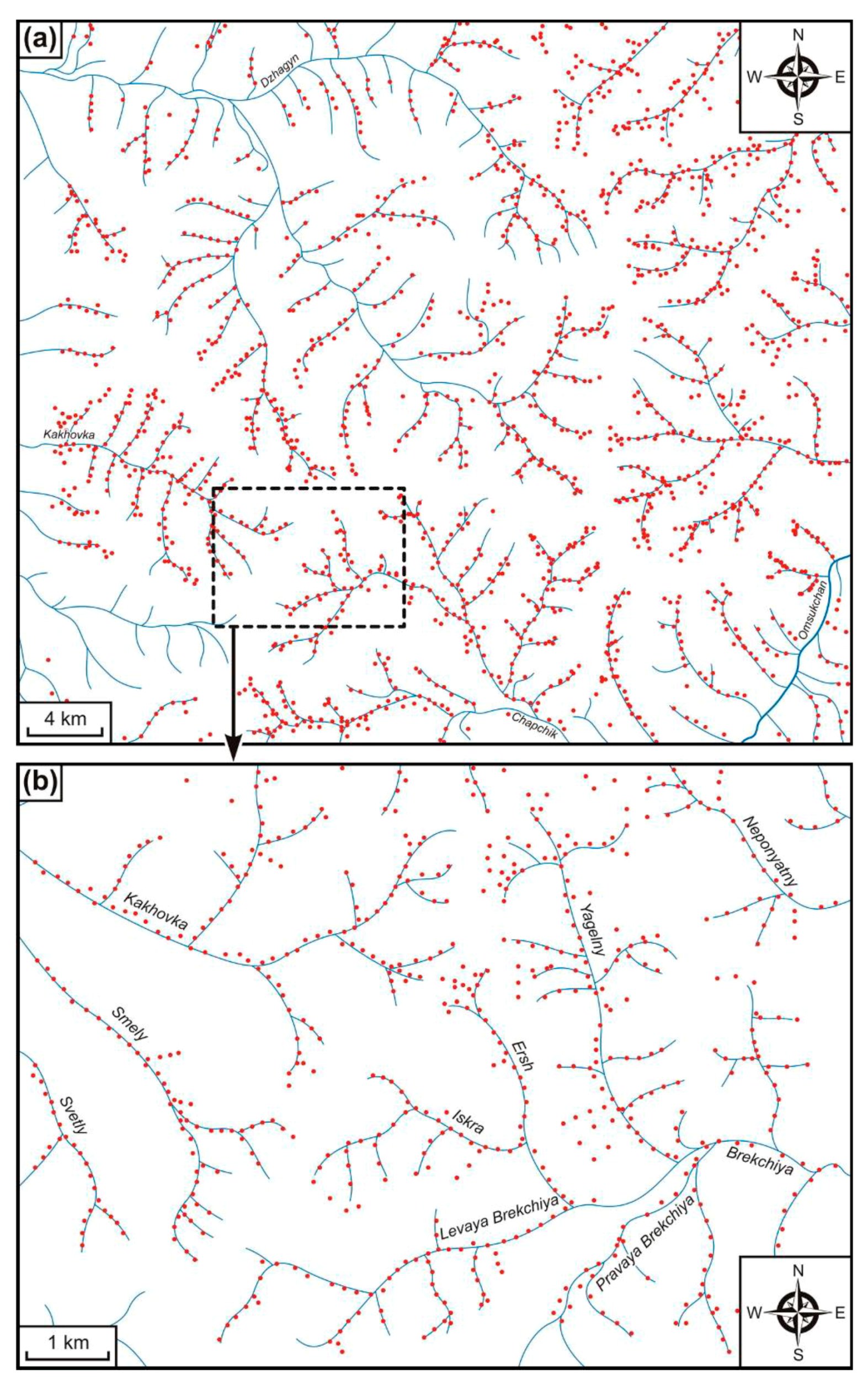





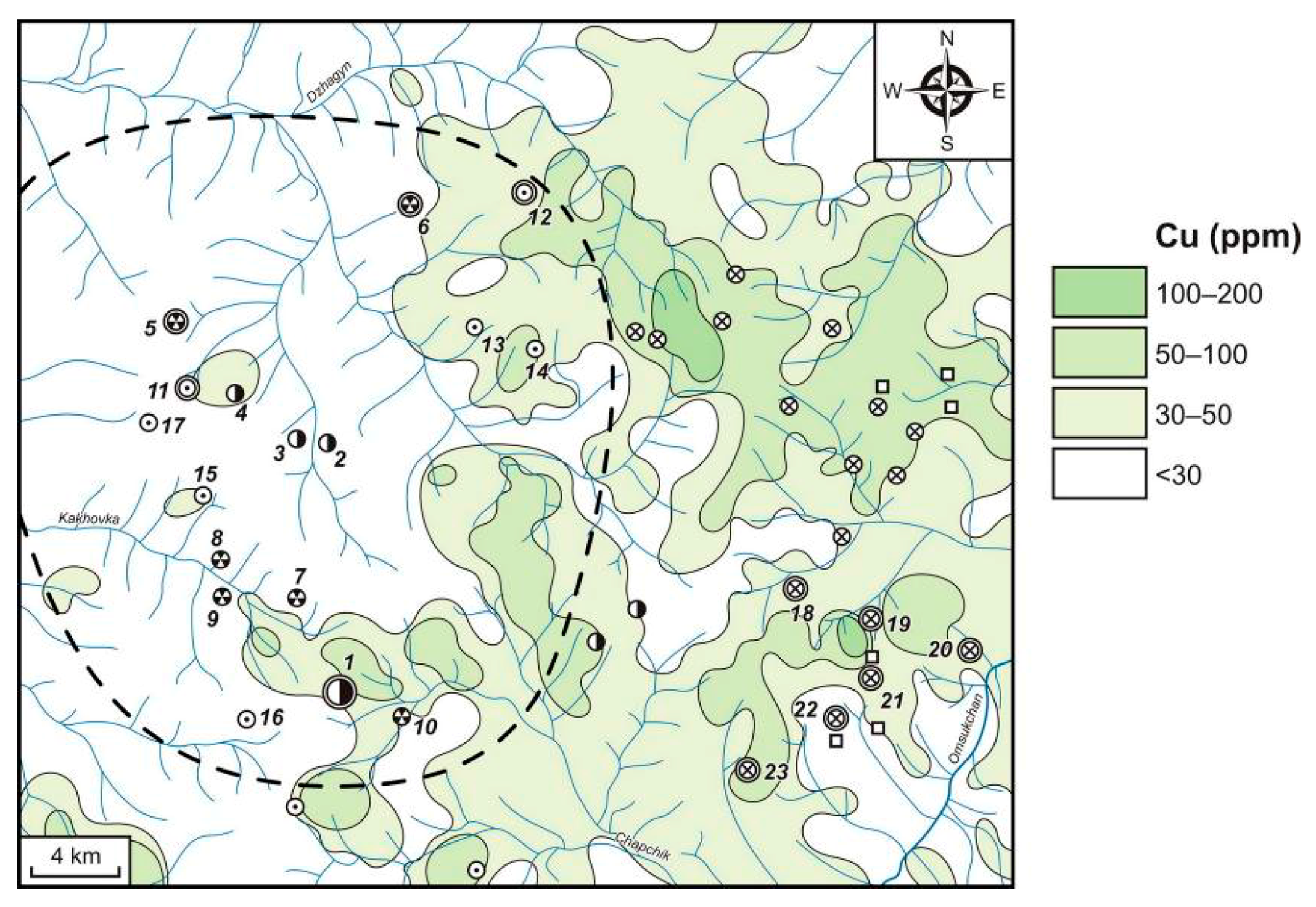





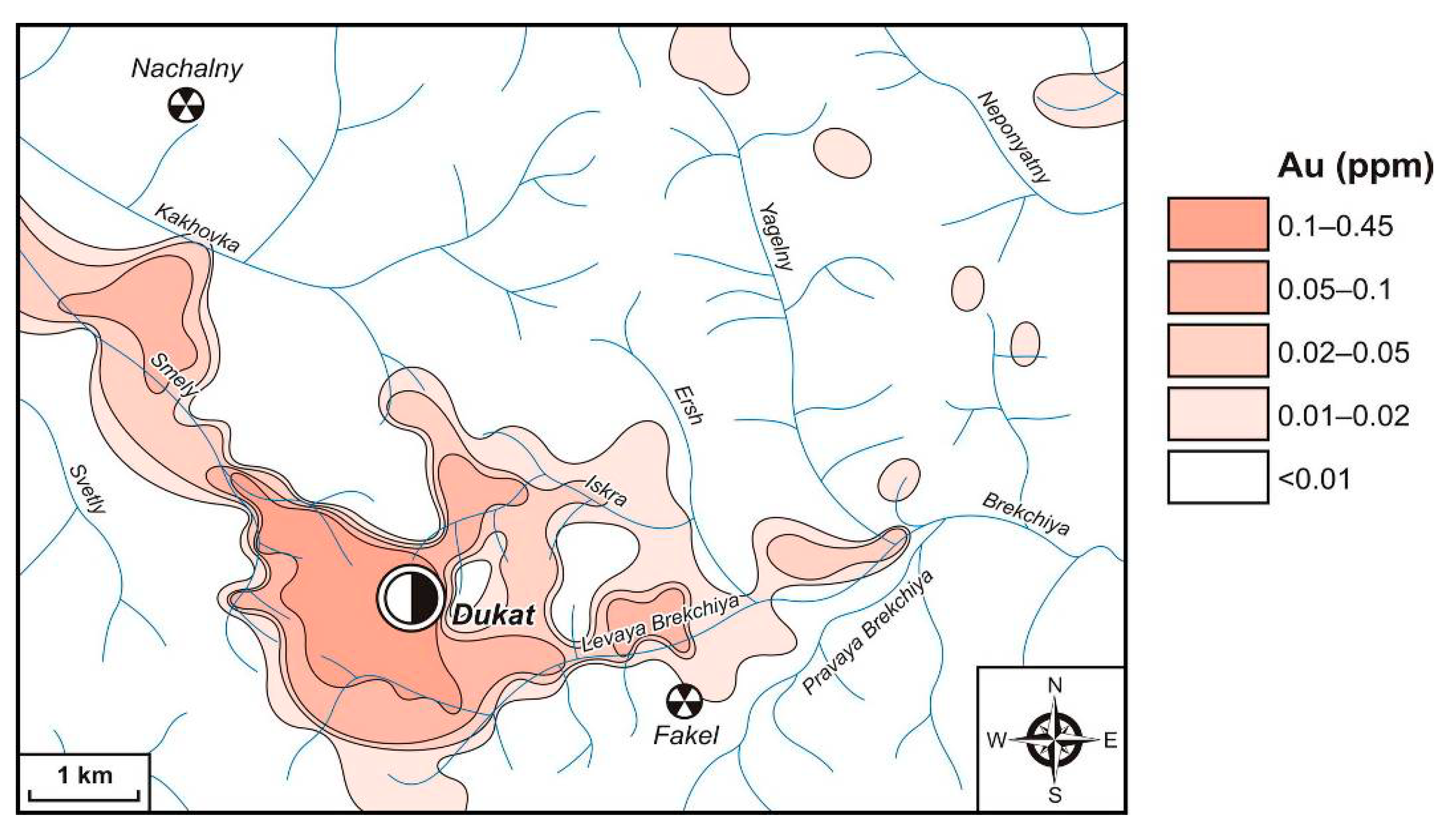

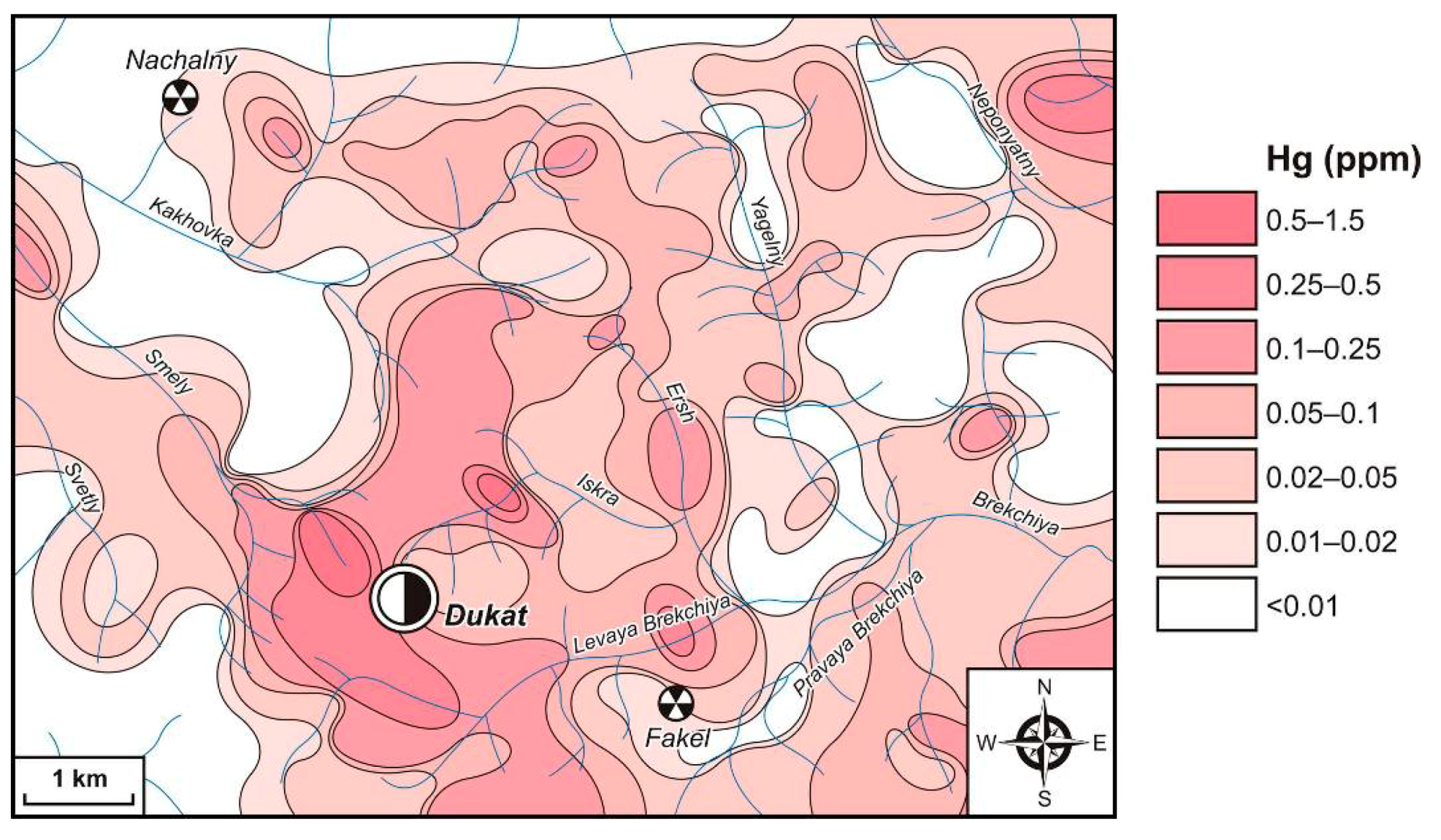
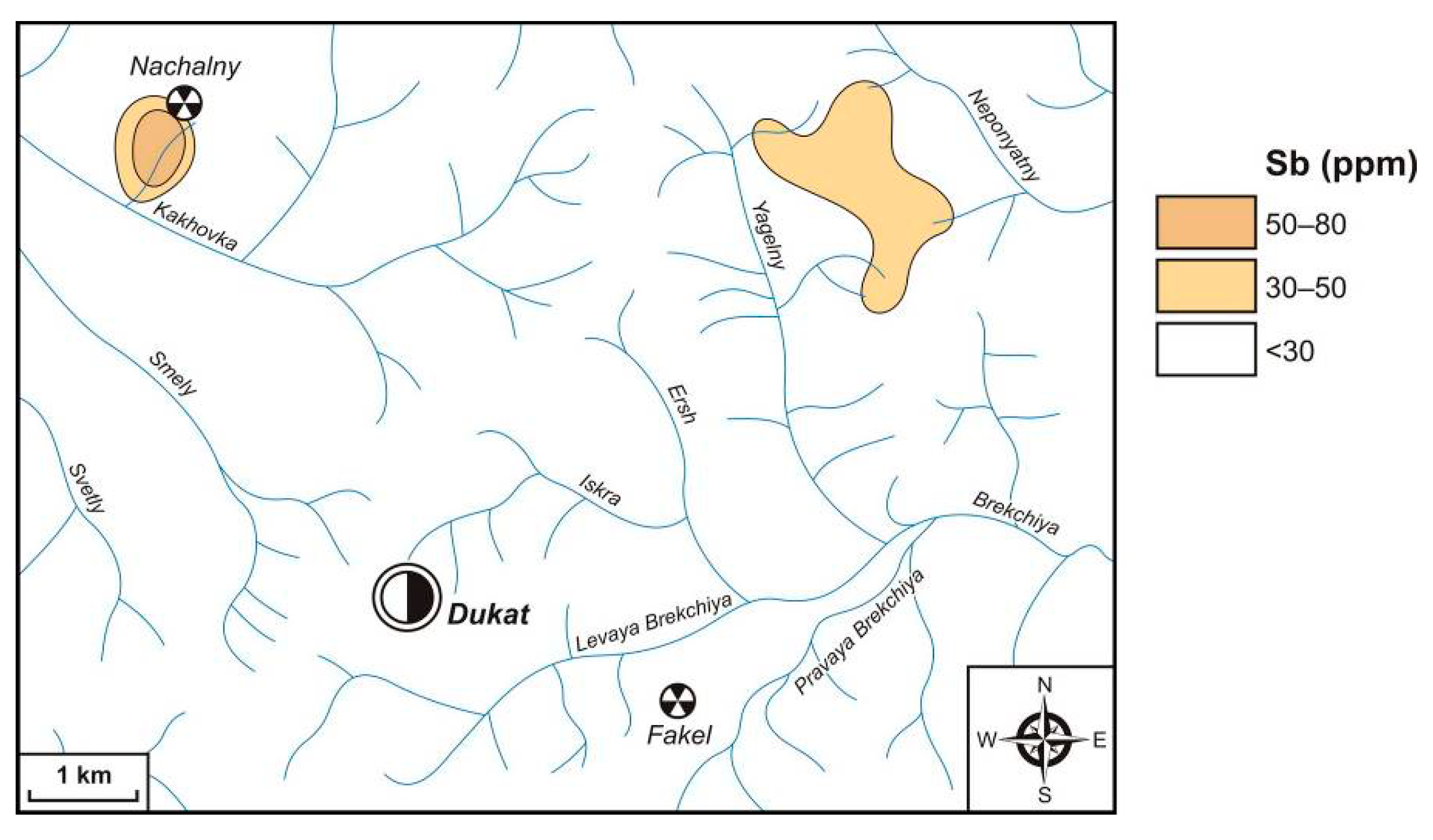



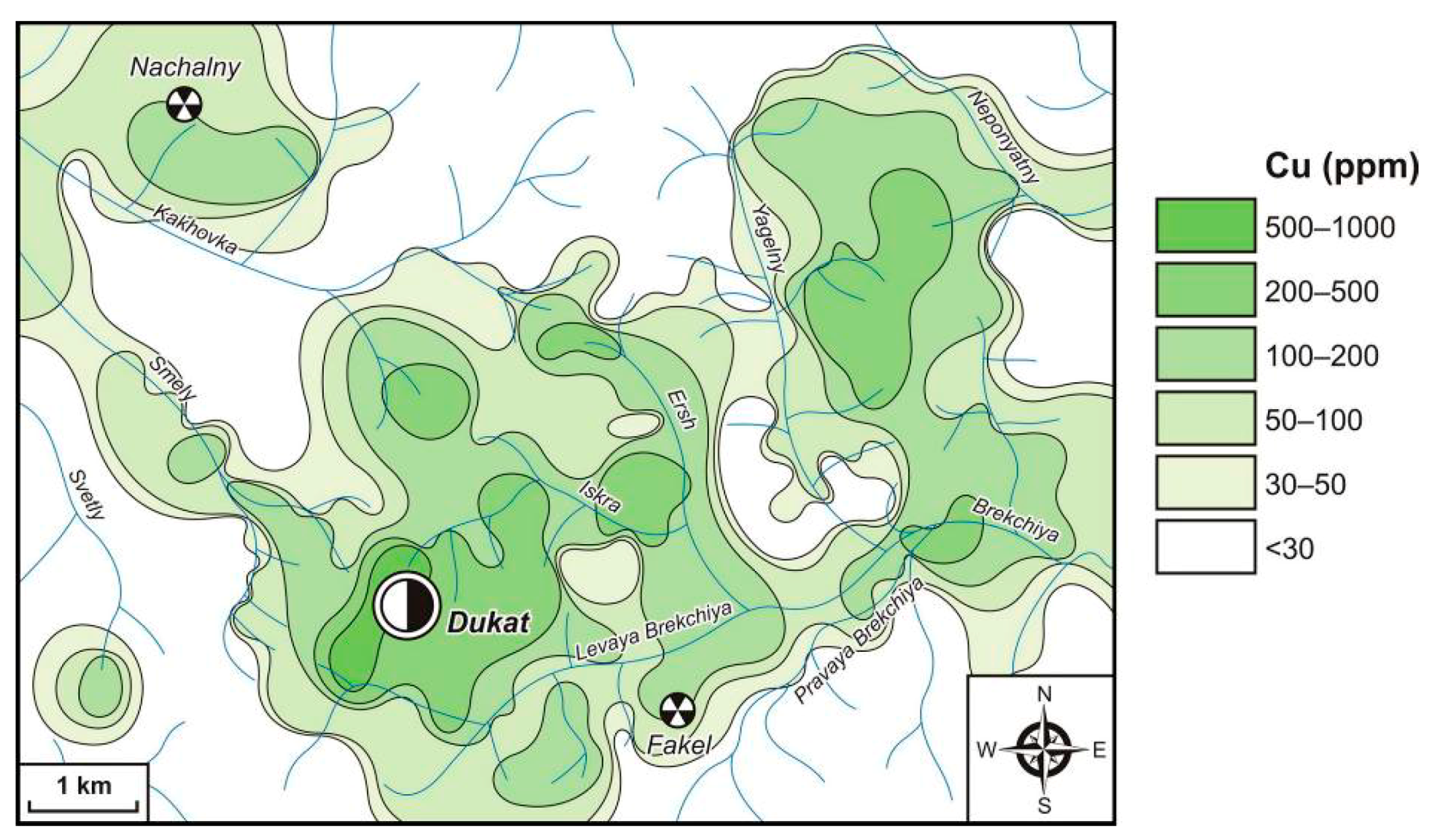


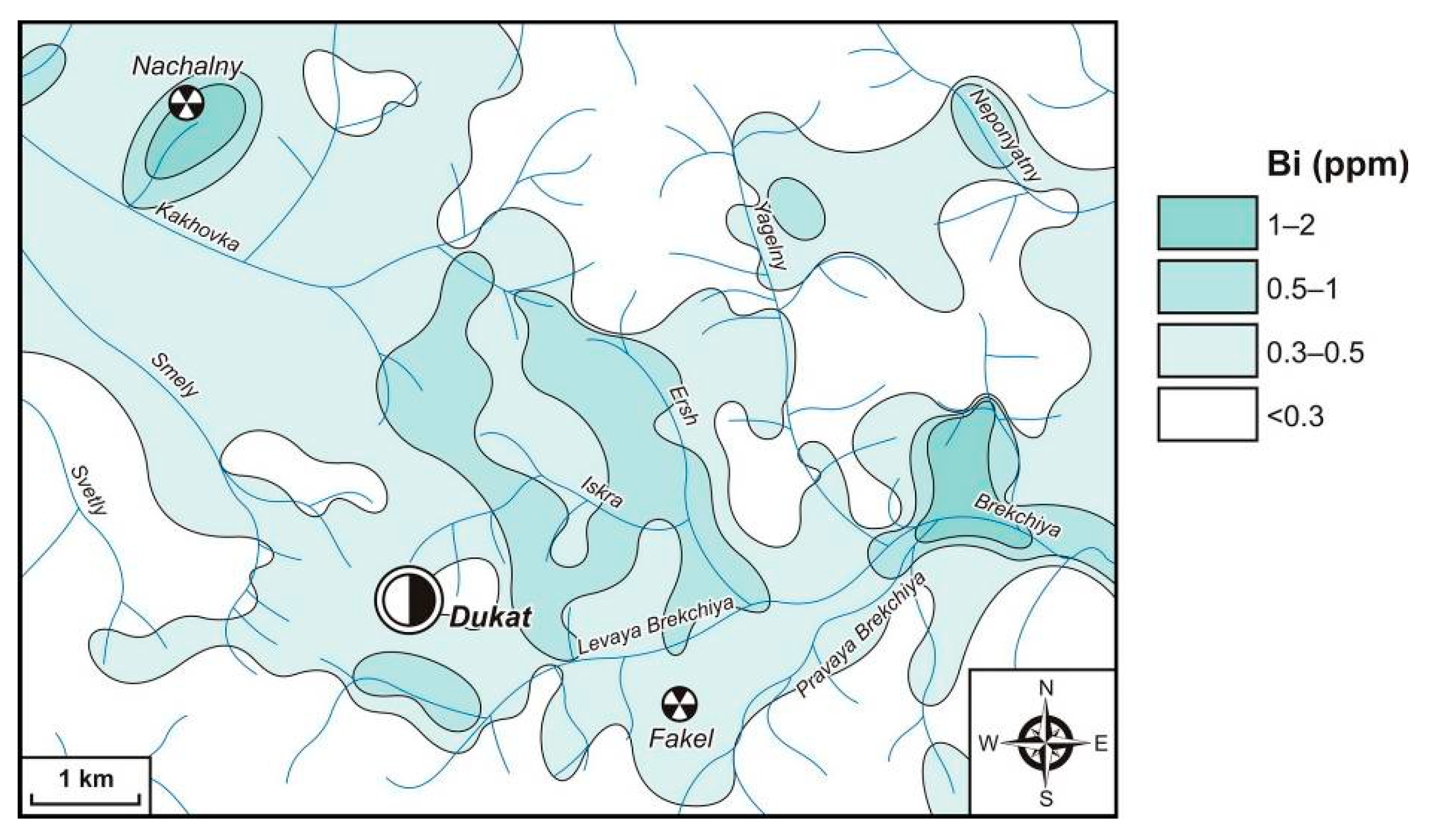
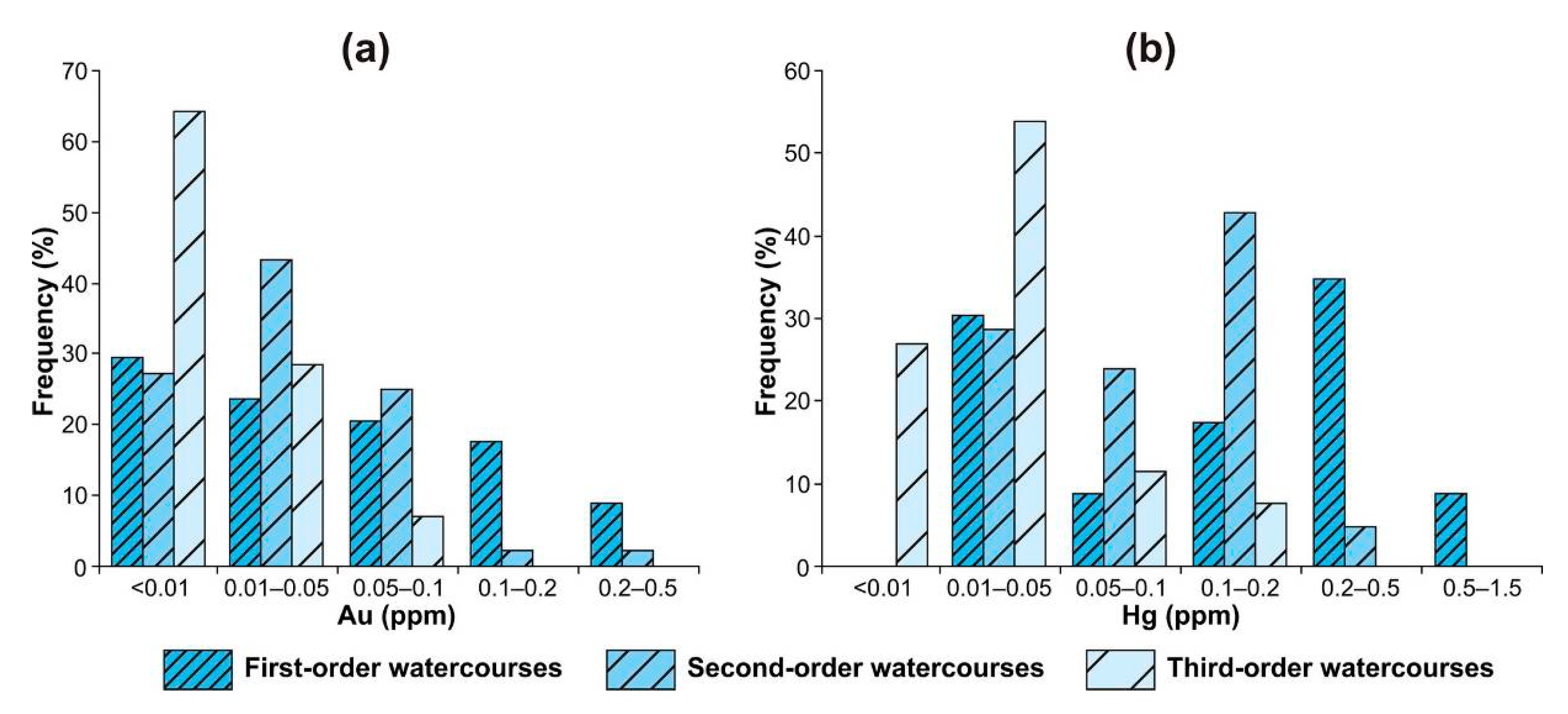
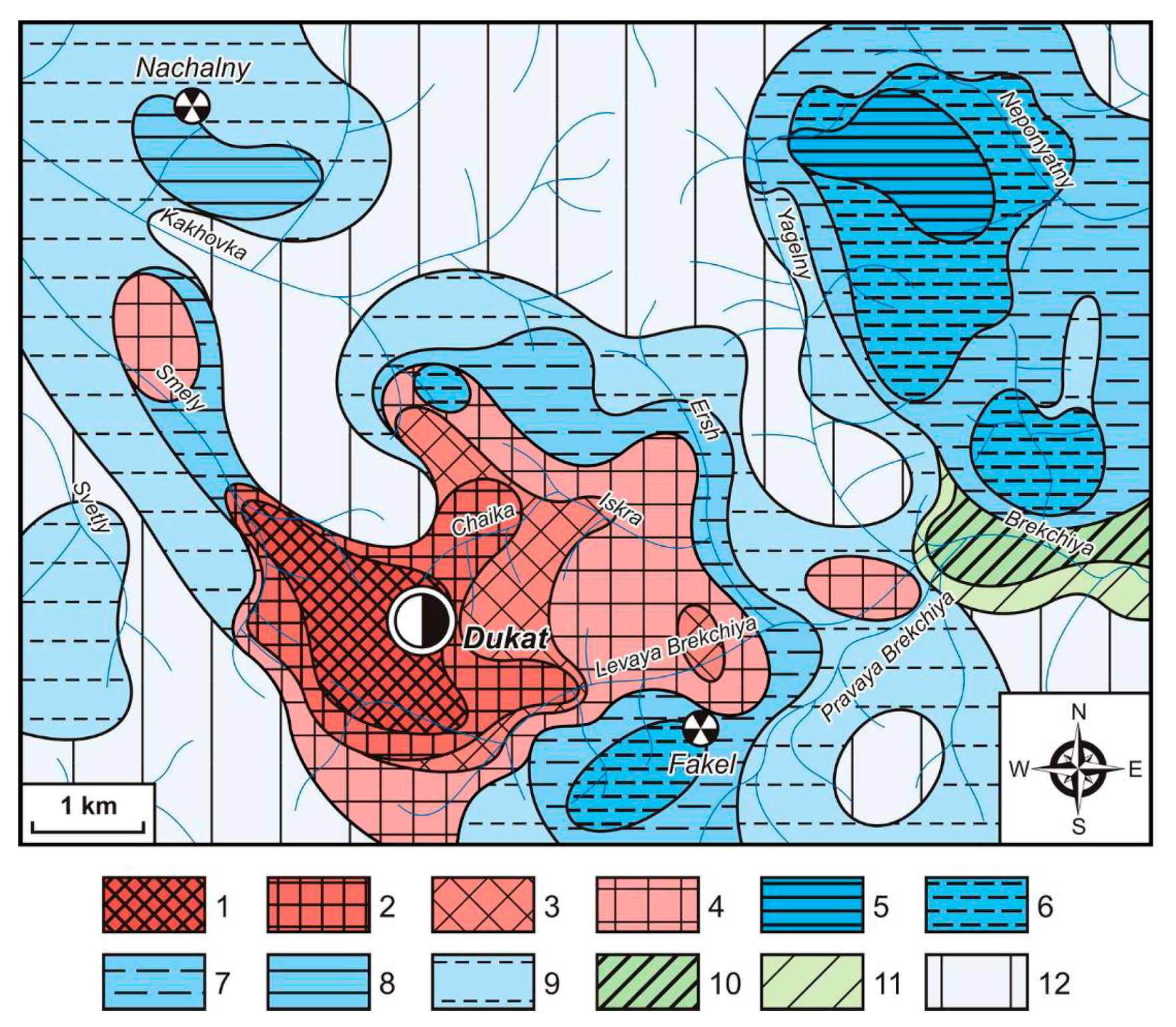



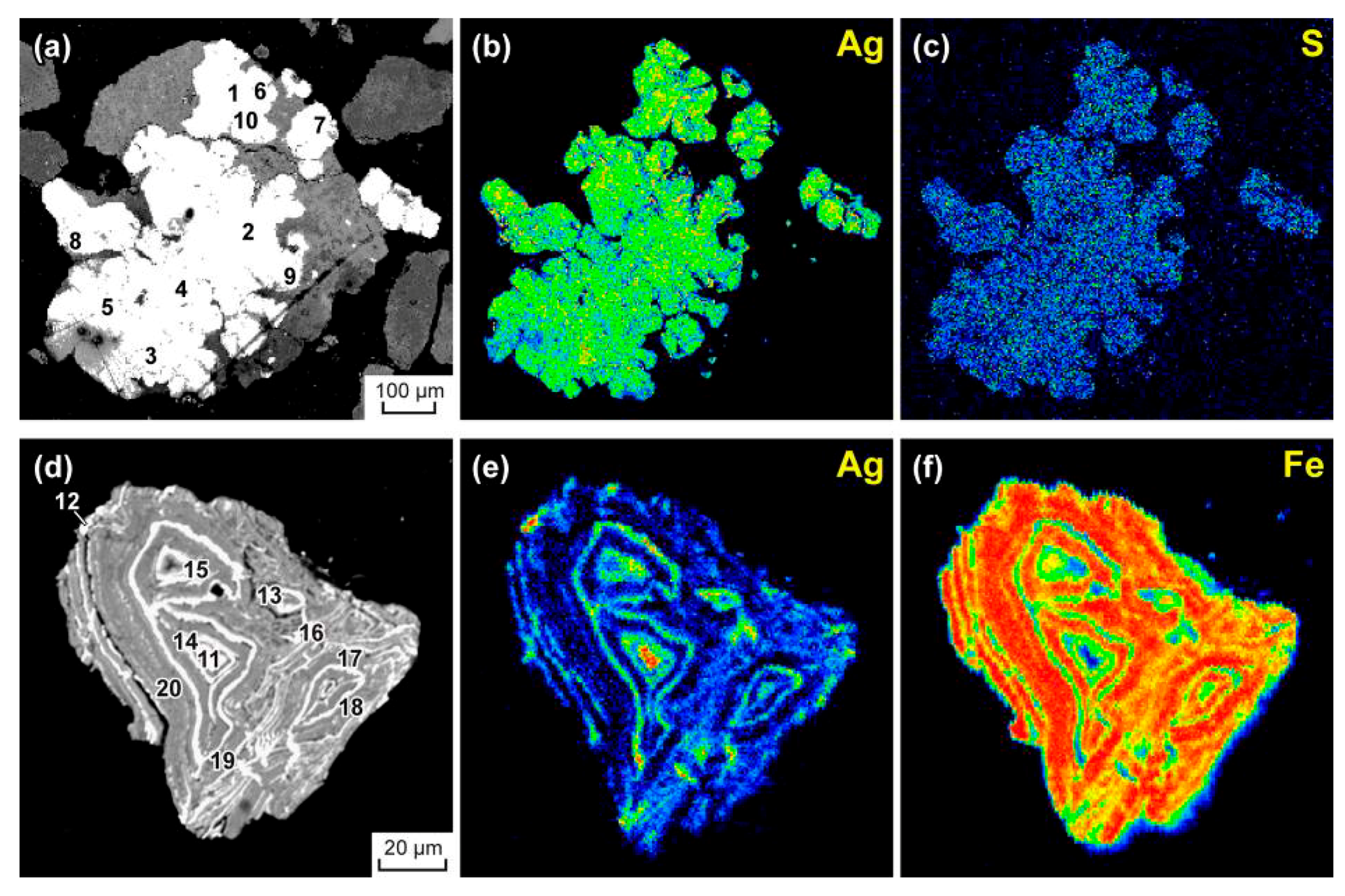
| Element | Сb | In Average Rocks | In Acidic Rocks | In the Crust | ||
|---|---|---|---|---|---|---|
| 1 | 2 | 3 | 4 | 5 | 6 | |
| Au | 0.005 | - | 0.0045 | 0.0043 | 0.00n | 0.004 |
| Ag | 0.1 | 0.07 | 0.05 | 0.07 | 0.0n | 0.07 |
| Hg | 0.005 | - | 0.08 | 0.083 | 0.n | 0.08 |
| Sb | 0.2 | 0.2 | 0.26 | 0.5 | 0.n | 0.2 |
| As | 2 | 2.4 | 1.5 | 1.7 | n | 1.8 |
| Pb | 10 | 15 | 20 | 16 | 20 | 12.5 |
| Zn | 50 | 72 | 60 | 83 | 40 | 70 |
| Cu | 10 | 35 | 20 | 47 | 100 | 55 |
| Mo | 1 | 0.9 | 1 | 1.1 | n | 1.5 |
| W | 2 | 1 | 1.5 | 1.3 | 50 | 1.5 |
| Sn | 2 | - | 3 | 2.5 | n | 2 |
| Bi | 0.1 | 0.01 | 0.01 | 0.009 | 0.0n | 0.17 |
| No. | Associations of Ore Elements |
|---|---|
| Predominantly Ag | |
| 1 | Ag(20/200) Pb(590/59) As(30/15) Bi(1.4/14) Zn(650/13) Cu(60/6) Sn(12/6) Au(0.01/2) |
| 2 | Ag(8.6/86) Pb(260/26) As(40/20) Bi(1.1/11) Zn(350/7) Sn(10/5) Cu(40/4) |
| Ag–Pb | |
| 3 | Pb(850/85) As(110/55) Ag(3.0/30) Zn(800/16) Bi(1.5/15) Sn(14/7) Cu(50/5) |
| 4 | As(150/75) Pb(450/45) Bi(3.5/35) Zn(600/12) Ag(1.0/10) Sn(18/9) Cu(40/4) |
| 5 | As(130/65) Bi(3.5/35) Pb(300/30) Zn(450/9) Ag(0.8/8) Sn(10/5) Cu(30/3) |
| Sn–Ag | |
| 6 | As(190/95) Bi(6.3/63) Sn(44/22) Pb(180/18) Ag(1.7/17) Zn(500/10) Cu(70/7) |
| 7 | As(110/55) Bi(3.3/33) Sn(20/10) Pb(100/10) Zn(400/8) Ag(0.6/6) Cu(40/4) |
| Mo–W and Sn–W | |
| 8 | Bi(5.2/52) As(90/45) W(60/30) Mo(20/20) Sn(36/18) Pb(70/7) Zn(300/6) Cu(50/5) Ag(0.4/4) |
| 9 | Sn(100/50) Bi(4.2/42) As(80/40) W(40/20) Mo(8/8) Pb(50/5) Zn(200/4) Cu(30/3) |
| Sn | |
| 10 | Sn(130/65) Bi(5.9/59) As(90/45) W(16/8) Zn(300/6) Cu(60/6) Mo(5/5) Pb(50/5) |
| 11 | As(90/45) Bi(3.9/39) Sn(42/21) Zn(300/6) W(10/5) Mo(5/5) Cu(50/5) Pb(50/5) |
| 12 | As(80/40) Bi(3.5/35) Sn(16/8) Zn(250/5) Pb(40/4) W(6/3) Mo(3/3) Cu(30/3) |
| Pb–Zn in ZDSM | |
| 13 | As(30/15) Bi(0.8/8) Sn(12/6) Zn(250/5) Pb(40/4) Cu(30/3) Ag(0.3/3) |
| 14 | Pb(30/3) Zn(150/3) Cu(20/2) Ag(0.2/2) |
| Minera- Lization Types | AGF Types | ||
|---|---|---|---|
| Endogenous (Ore + Primary Halo) | Exogenous (Secondary Halo) | Exogenous (Stream Sediments) | |
| Ag, Au–Ag | (Zn, Cu, Bi) | (Bi, Zn, Sn, Cu, Au) | |
| Ag–Pb | (Sn, Cu, Bi) | (Bi, Sn, Cu) | |
| Sn–Ag | |||
| Watercourse Orders | I | II | III | |||
|---|---|---|---|---|---|---|
| Elements | Au | Hg | Au | Hg | Au | Hg |
| Minimum content | <0.006 | 0.017 | <0.006 | 0.022 | <0.006 | 0.005 |
| Maximum content | 0.45 | 1.5 | 0.23 | 0.33 | 0.090 | 0.12 |
| Average content | 0.078 | 0.28 | 0.041 | 0.10 | 0.017 | 0.034 |
| Number of samples | 34 | 23 | 44 | 21 | 42 | 26 |
| Nos. | Ore Element Associations |
|---|---|
| Predominantly Ag and Au–Ag | |
| 1 | Ag(27/270) Pb(1800/180) Hg(0.3/60) Au(0.2/40) Zn(2000/40) Cu(350/35) As(20/10) Bi(0.4/4) |
| 2 | Ag(14/140) Pb(1000/100) Hg(0.26/52) Au(0.1/20) As(40/20) Cu(190/19) Zn(900/18) Bi(0.4/4) |
| 3 | Ag(11/110) Pb(800/80) As(60/30) Hg(0.12/24) Cu(210/21) Au(0.055/11) Zn(500/10) Bi(0.4/4) |
| 4 | Ag(6/60) Pb(500/50) As(80/40) Cu(180/18) Hg(0.05/10) Au(0.03/6) Zn(250/5) Bi(0.5/5) |
| Ag–Pb | |
| 5 | As(1350/675) Pb(2800/280) Sb(40/200) Ag(19.5/195) Cu(170/17) Zn(600/12) Hg(0.06/12) Bi(0.3/3) Sn(6/3) |
| 6 | Pb(1500/150) As(160/80) Ag(6/60) Cu(200/20) Zn(550/11) Hg(0.05/10) Bi(0.4/4) Sn(6/3) |
| 7 | Pb(600/60) Ag(5/50) As(80/40) Cu(180/18) Zn(400/8) Hg(0.04/8) Bi(0.6/6) Sn(8/4) |
| 8 | Sb(45/225) Pb(480/48) Ag(4.6/46) As(70/35) Zn(800/16) Cu(150/15) Bi(1/10) Sn(16/8) Hg(0.02/4) |
| 9 | Ag(2/20) As(30/15) Pb(100/10) Cu(50/5) Zn(200/4) Bi(0.3/3) |
| Sn–Ag | |
| 10 | Ag(5.2/52) Sn(70/35) As(60/30) Cu(200/20) Pb(190/19) Zn(800/16) Bi(1.5/15) |
| 11 | Ag(2.2/22) As(34/17) Sn(30/15) Cu(90/9) Pb(80/8) Zn(300/6) Bi(0.6/6) |
| Pb–Zn in ZDSM | |
| 12 | As(10/5) Ag(0.3/3) Bi(0.3/3) Pb(30/3) Zn(100/2) Cu(20/2) |
| No. | Ag | Fe | Pb | Cu | Se | S | Total |
|---|---|---|---|---|---|---|---|
| Acanthite | |||||||
| 1 | 84.87 | 0.53 | <0.30 | <0.30 | <0.20 | 14.05 | 99.45 |
| 2 | 85.95 | 0.42 | < | < | 0.29 | 14.05 | 100.71 |
| 3 | 88.39 | 0.35 | < | < | <0.20 | 12.70 | 101.44 |
| 4 | 83.29 | 0.31 | < | < | 0.49 | 12.45 | 96.54 |
| 5 | 84.79 | 0.42 | < | < | 1.64 | 13.46 | 100.31 |
| Weakly corroded part of acanthite grain | |||||||
| 6 | 78.85 | 6.59 | < | < | 0.51 | 12.64 | 98.59 |
| 7 | 72.79 | 10.25 | < | < | <0.20 | 12.54 | 95.58 |
| 8 | 72.27 | 11.13 | < | < | < | 13.12 | 96.52 |
| 9 | 70.47 | 11.74 | < | < | < | 13.99 | 96.20 |
| 10 | 68.86 | 12.11 | < | < | < | 13.62 | 94.59 |
| Acanthite | |||||||
| 11 | 81.08 | 3.59 | < | 0.55 | < | 13.49 | 98.71 |
| 12 | 79.25 | 5.38 | < | 0.37 | < | 13.87 | 98.87 |
| Acanthite + Fe hydroxides | |||||||
| 13 | 42.25 | 26.47 | 0.39 | 1.14 | < | 9.79 | 80.04 |
| 14 | 53.79 | 20.68 | 0.52 | 1.40 | < | 9.43 | 85.82 |
| 15 | 46.74 | 19.41 | 0.92 | 1.45 | < | 9.39 | 77.91 |
| 16 | 46.97 | 25.09 | <0.30 | 0.99 | < | 8.06 | 81.11 |
| Fe hydroxides + acanthite | |||||||
| 17 | 4.97 | 54.44 | 2.23 | 0.38 | < | 0.82 | 62.84 |
| 18 | 5.58 | 54.73 | 1.82 | 0.36 | < | 1.25 | 63.74 |
| 19 | 3.92 | 55.50 | 2.24 | 0.35 | < | 0.66 | 62.67 |
| 20 | 7.81 | 53.43 | 2.02 | 0.31 | < | 1.48 | 65.05 |
© 2019 by the authors. Licensee MDPI, Basel, Switzerland. This article is an open access article distributed under the terms and conditions of the Creative Commons Attribution (CC BY) license (http://creativecommons.org/licenses/by/4.0/).
Share and Cite
Makshakov, A.S.; Kravtsova, R.G.; Tatarinov, V.V. Lithochemical Stream Sediments of the Dukat Gold–Silver Ore-Forming System (North–East of Russia). Minerals 2019, 9, 789. https://doi.org/10.3390/min9120789
Makshakov AS, Kravtsova RG, Tatarinov VV. Lithochemical Stream Sediments of the Dukat Gold–Silver Ore-Forming System (North–East of Russia). Minerals. 2019; 9(12):789. https://doi.org/10.3390/min9120789
Chicago/Turabian StyleMakshakov, Artem S., Raisa G. Kravtsova, and Vasiliy V. Tatarinov. 2019. "Lithochemical Stream Sediments of the Dukat Gold–Silver Ore-Forming System (North–East of Russia)" Minerals 9, no. 12: 789. https://doi.org/10.3390/min9120789
APA StyleMakshakov, A. S., Kravtsova, R. G., & Tatarinov, V. V. (2019). Lithochemical Stream Sediments of the Dukat Gold–Silver Ore-Forming System (North–East of Russia). Minerals, 9(12), 789. https://doi.org/10.3390/min9120789





